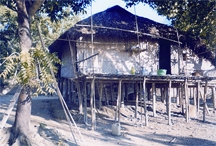Chak, The
Chak, The one of the smallest ethnic groups in Bangladesh. According to the census of 1991, there was only 2000 Chak population belonging to 372 families. Their settlements are concentrated in Naiskhyongchhari upazila of Bandarban district in the Chittagong Hill Tracts. They live in the upazila headquarters and in villages like Baishari, Kamichhara, Crokshong, Bakkhali, Alekhyong, Kroangjhiri and Duchhri. In the Bomang royal book of Bandarban Bomang circle and in the documents prepared during the coronation of Bomang king. The' Chak ethnic group was enlisted as 'Mingsak'.

Chaks belong to the Mongoloid race having yellowish complexion, medium face with a fatty snap-nose and folded eyelids. Chak society is divided into two clans and each clan is divided into several sub-clans. Each class has its separate symbol called Jaloa or Paita (a sort of twisted cotton rope).
According to Thoai Shoi Khain, an anthropologist and researcher, the ancestral home of the Chak was in Yunang, China. They were known as 'big ear race'. The tradition of wearing large-size ornaments for decorating ears of the Chak women is still in practice. Another researcher Aungsa U along and Thoai Shoi Khain are of the opinion that the Chak people migrated from Yunang to present Myanmar and its northern frontier area Hugong. francis buchanan in his travelogue Farancis Buchanan in South East Bengal (1798) has also mentioned the existence of the Chak community. In the fourteenth and fifteenth century, Burma and Arakan experienced a serious political turmoil which compelled a group of the Chak people to migrate to Lama in Chittagong Hill Tracts of Bangladesh by crossing the Kaladeng River and the Chengda Mountains of the present Rakhain province.'

The livelihood of Chak population is very colourful and traditional especially in celebrating festivals and observing rituals related to marriage, childbirth, death and funeral. They believe in the concept of re-birth, and their variety of rituals of birth, death and marriage ceremonies are very exclusive in nature. They speak in a language belonging to 'Sak' or 'Lai' group of Tibet-Burman branch under the Sino-Tebetean language family. The written form of this language has not yet been found in Bangladesh, although Chak poets and lyricists have composed many poems and songs. The leading Chak poets and lyricists of Bangladesh are: Wang Ching Chak, Cha Ma Prue Chak, Nang U Chak, Chaichha Aung Chak, Maungnu Chak, Mong Koching Chak and Mong Mong Chak. They play on various indigenous musical instruments as well as flute, drum and bell.
Chak religious leader Mahathero Gandarba Wengsar took an initiative for educating in the community in 1959 and his effort started yielding positive result from 1966 when the first Chak graduate came out successfully. By now the literacy rate of the Chak community has gone up and many of them are engaged in government and private services. They wear traditional attires made by them. Chak males love to dress up with Kotung Pangre (dhuti) and Apong (turban) and Chak ladies like to wear Nafi (a sort of skirt) and Rangkeng (brassier). Weaving of a special type of blanket with prominent design and making of ornaments of their own design is a tradition of Chak community. Chak women use extra large size earrings and they are identified by the special earrings. They are also fond of using other ornaments.

Chaks often worship other gods and goddesses like Luxmi or Waigya, although they are Buddhist. They celebrate many religious and folk festivals throughout the year. Their society is patriarchal and the families are of three types. Only the sons inherit the family property. The government appoints the headman of the community on the basis of competency and hereditary right and the headman gets allowance from the government.
Traditionally, the Chak lifestyle is agro-based and they are closely linked with both jhum cultivation and plain field cultivation, although the production of jhum cultivation has been decreased. They build up their residence and prayer houses with their own materials. In Chak language house and village are called King and Thea respectively. Rice, vegetables, dried fish, fresh fish and meat are their favourite foods.
Being a very small ethnic group the Chak community in Bangladesh could pressure its rich cultural trend in all sphere of life. This achievement has given them a separate identity. Their ceremonial performances of songs seeking divine blessings for maintaining the inter-class harmony and welfare for a newborn baby are very unique in terms of composition and practice. [Rakhi Roy]
